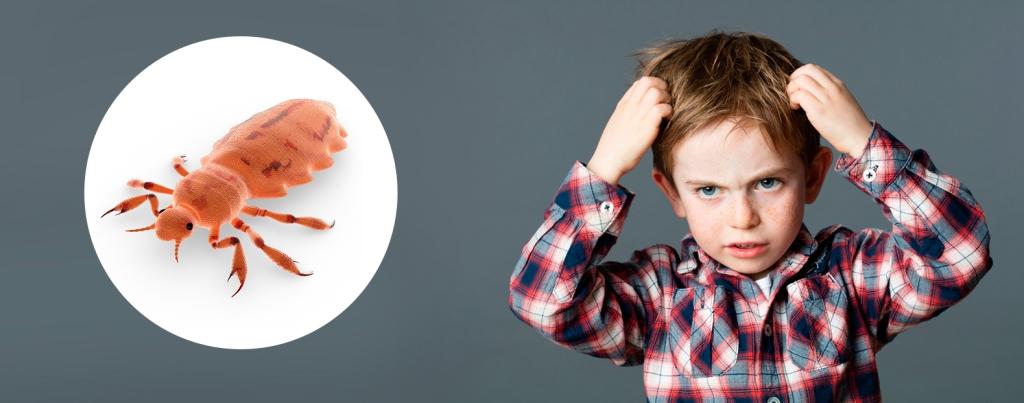LICE AND NITS
WHAT ARE LICE OR NITS?
The louse (plural: lice) is a parasite that attaches itself to human hair and feeds on human blood. The most prevalent kind of lice is head lice. The Centers for Disease Control and Prevention (CDC) estimate that up to 12 million lice infestations occur every year in the United States.Female adult lice can lay up to six eggs every day. Eggs are laid right onto the roots of hair. The eggs take about a week to hatch, producing a nymph. The nymphs then go through three successive growth spurts. During these spurts, they molt until they reach adult size.

HOW CAN YOU KNOW?
Adult lice are about the size of a sesame seed and can be very hard to see, because they can be any color from white to tan to brown. Lice typically feed on blood four to five times each day.While it’s important to note that lice infestations can happen to anyone, it’s more common to occur in children aged from 3-12. Lice are most often found on children attending child care, preschool, and elementary school. Lice are also often transferred to the household members of infested children.
From the literature it is evident that (for example Epidemiol Mokrobiol, Imunol 55, 2006, No 3, pages 112-119) the appearance of lice has increased in the last 10 years worldwide. This is due to the loss of efficacy of the delouse products due to the resistance to insecticides that these products contain. The appearance of lice is fluctuating. Data from different countries about lice appearance ranges from 2 to 60%. Statistically accurate data are, however, unavailable because the presence of lice (pediculosis) is not subject to compulsory reporting of transmitted infectious diseases. What are the most frequently infested age group?
While it’s important to note that lice infestations can happen to anyone, it’s more common to occur in children aged from 3-12. Lice are most often found on children attending child care, preschool, and elementary school. Lice are also often transferred to the household members of infested children.
Contrary to popular misconception, lice are unrelated to personal hygiene. Keeping your children clean does not protect them from contracting lice from other kids at school--this is why we recommend our Lice Repellent chest pins, hair bands and accessories, which repels lice before you get infested, not while like other products.
WHAT IS OUR EFFECTIVE PREVENTION?
Our hair bands and pins do give a repellent effect but because it is a herbal solution it does not give a 100% guarantee but it does reduce potential risk significantly. The Cinnamomum camphora, also known as Cinnamomum camphorum. This green tree always reaches a height of up to 20 meters. It comes from Southest Asia, but it has also grown in North America. Camphor extract is often used in the pharmaceutical industry as an additive to ointments for blood circulation, for rheumatic and respiratory problems, relieves muscle and joint pain. In the Far East, even before the Ottoman Empire, they stitched the extract from the canopery into the collar of the soldiers to prevent the spread of lice. Lavender comes from the Western Mediterranean as the first to discover the healing effects of Lavender Romans. They used it as an antiseptic, repellent or as a wash. The name lavender comes from the Latin word "lavare", which means washing. Old moms put them in the wardrobes to wear a mole or pillows for a peaceful and undisturbed sleep. In combination with the cannopharm, the repellent effect against lice is even higher.
HOW DOES ONE GET RID OF LICE AS EFFECTIVELY AS POSSIBLE?
Frequent hair washing partially prevents hair parasites propagation, but this measure can not be considered as sufficient. The washing itself will not remove the lice from the hair. Our hair bands and pins do give a repellent effect but because it is a herbal solution it does not give a 100% guarantee but it does reduce potential risk significantly. Once infected, it is necessary to treat head lice with products available on the market (shampoo, lice comb, insecticide spray, hair gel, conditioner etc.). If the treatment does not succeed there may be further treatments. At the same time some things should be avoided such as washing hair at high temperatures. Also bed linens must be dried thoroughly and ironed. Hats, scarves, shawls and other clothing that is not always worn should be avoided if possible. Mattresses and mats used in school should also be sprayed with the insect repellent. Articles in direct contact with the hair (combs, brushes) are to be treated with insect repellent or soaked in a solution containing chlorine. Family members are to ensure a high level of personal hygiene. Each member of the family must use their personal hygiene articles (towel, comb etc.) to prevent it passing on. The same applies in the case of caps, scarves or other headgear. Louse disease is included in the International Classification of Diseases under code B85. On this basis, the physician is obliged to provide appropriate treatment - preventive care, either alone or in collaboration with the specialist.
IS IT DESEASE?
Louse disease is included in the International Classification of Diseases under code B85. On this basis, the physician is obliged to provide appropriate treatment - preventive care, either alone or in collaboration with the specialist.




